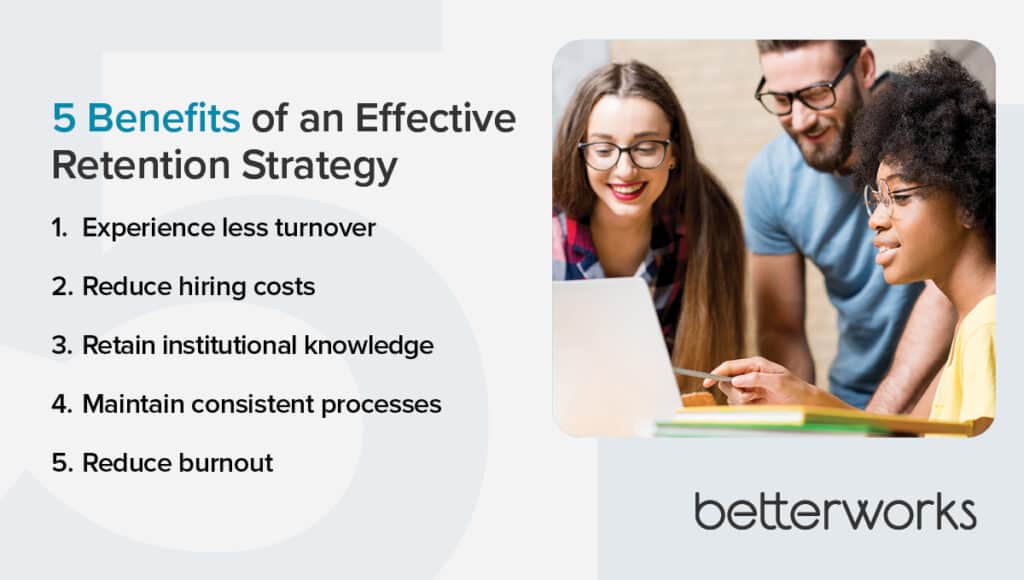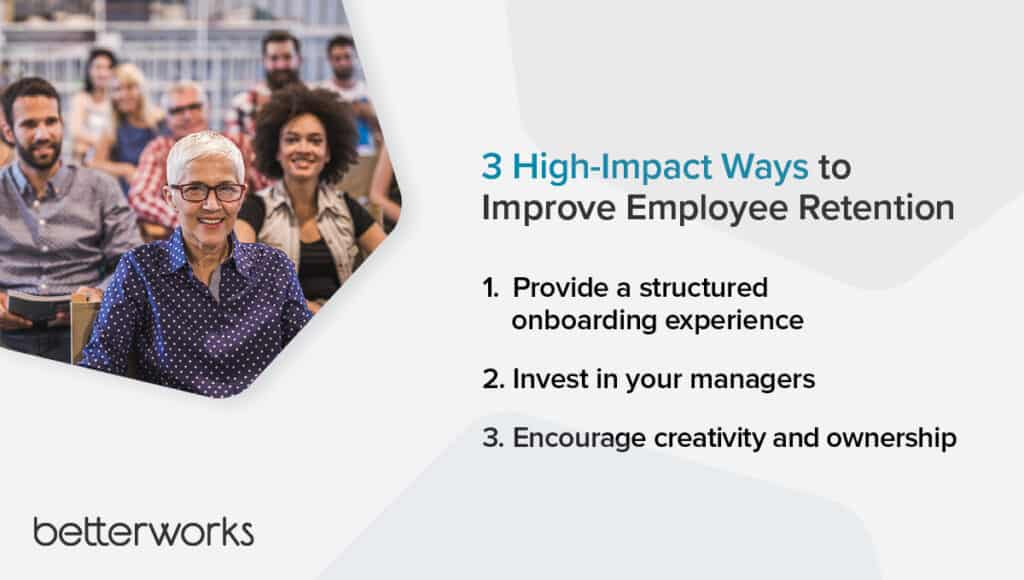- Employee retention vs. employee turnover
- Benefits of an effective retention strategy
- 9 employee engagement and retention strategies that actually work
- Provide a structured onboarding experience
- Promote mentorship programs
- Get recognition right
- Implement clear communication frameworks
- Invest in your managers
- Implement flexible work options
- Encourage creativity and ownership
- Create a workplace culture that employees want to be part of
- Invest in your employees’ careers
- Find growth with employee retention strategies
Turnover isn’t inevitable. It’s the result of choices your employees make after comparing the opportunities available to them in your organization to those they could pursue elsewhere. Modern employee retention strategies help close that gap before you’ve lost them.
The Great Resignation made this more urgent for many employers, but it’s important to remember that the high rate of turnover many employers saw during that time wasn’t solely a pandemic phenomenon.
Dr. Anthony Klotz, associate professor of organizational behavior at University College London’s UCL School of Management and the person who first who coined the term “The Great Resignation,” noted in his People Fundamentals webinar with Betterworks, that the quit rate, a federal measurement of U.S. employee voluntary departures, was already at a historic high in 2019. People are quitting at twice the rate they did a decade ago, and they are still above 2019 levels.
If you want to counteract that trend at your organization, you’ll need to customize your strategy to match your workforce’s unique wants and needs. Consider these nine effective employee retention strategies to inspire your own retention planning efforts.
Employee retention vs. employee turnover
While employee retention and employee turnover are sometimes used interchangeably, they aren’t the same. Retention is calculated by the percentage of employees who stay over a given period, whereas turnover measures the rate of employees who leave over time.
From an organizational perspective, efforts to increase employee retention are usually proactive, while efforts to reduce employee turnover are often reactive.
What causes turnover?
Employees leave companies for many reasons, including layoffs, retirements, or better opportunities elsewhere. However, many instances of voluntary turnover are a response to perceived employer deficiencies, including inadequate compensation or benefits, ineffective management, poor workplace culture, and a lack of career development opportunities.
For example, a Pew Research Center survey found that low pay, a lack of advancement opportunities, and feeling disrespected at work were the top three reasons Americans quit their jobs in 2021.
And while voluntary turnover includes employees radically changing their career path or leaving for an incredible opportunity their current employer can’t match, many resign simply because they want something else. The Betterworks 2022 State of Performance Enablement Research Report found that 72% of departing employees leave companies primarily to get away from their old job – not necessarily because they are passionate about the new opportunity.
Benefits of an effective retention strategy
An effective employee retention strategy leads to a more stable, experienced and knowledgeable workforce, and the impact is felt throughout the organization.
Experience less turnover
Reducing employee turnover is the primary goal of an employee retention strategy. Voluntary quits have been a challenge for U.S. employers since before the pandemic, and the quits rate remained elevated into late 2022.
Lower turnover means you don’t have to backfill as many roles or ask your remaining employees to shoulder as much work.
Reduce hiring costs
Hiring and onboarding new employees is expensive, especially in a competitive job market. The cost of replacing a full-time employee can range from $4,700 to as much as four times the annual salary, according to data from the Society for Human Resource Management (SHRM).
Higher employee retention means fewer job openings and fewer costs incurred on temporary workers. It also translates into higher productivity and enables your organization to avoid lost business opportunities due to being short-handed. Your payroll costs could be lower, too, because your organization isn’t competing for top performers on the open market, where highly skilled candidates have more leverage to negotiate their compensation and benefits.
Retain institutional knowledge
When seasoned employees leave, they take their skills and institutional knowledge. When that knowledge isn’t documented or passed on, your organization can suffer from confusion, disorganization, and reduced output.
Higher retention, on the other hand, preserves that Institutional knowledge. And this can also pay benefits for older employees looking to retire. You can’t retain them forever, but if they are engaged and happy, they’re probably more willing to pass along their knowledge before they retire.
Maintain consistent processes
Your existing workforce is already familiar with your internal culture and procedures, which helps them deliver consistent, reliable work. New hires can bring a lot of positive energy to a team, but they still have a learning curve and need time to learn both formal practices and informal habits.
Consistency can also help your organization when you promote from within. These newly elevated leaders are familiar with your business and culture. They might make changes, but they’ll do so with an understanding of the institution.
Reduce burnout
Burnout and high rates of turnover create a vicious cycle. Burnout contributes directly to voluntary turnover, with 40% of employees surveyed by Limeade in 2021 citing it as a factor.
Those same high rates of turnover also contribute to the stress of the workers still on the team, especially if the roles aren’t backfilled quickly.
When HR leaders cultivate a positive workplace culture that emphasizes work-life balance and regular check-ins, managers are better equipped to spot the signs of burnout, intervene, and stop the cycle.

9 employee engagement and retention strategies that actually work
Provide a structured onboarding experience
The onboarding process sets the tone for an employee’s experience with the company.
Onboarding can start before an employee’s first day, with HR providing a comprehensive, user-friendly onboarding packet. In many cases, employees can fill out paperwork and get set up with company equipment ahead of time, which frees them to spend their first day learning more about the job and your organization’s expectations.
Onboarding is also an opportunity to engage new hires by setting clear performance management expectations and professional development goals. By showing new talent what they need to do to succeed — and how HR and managers will support them — they’ll begin to see how they can achieve their professional goals within your organization.
Recommended read

Performance Management
Promote mentorship programs
One way to invest in employees and help them grow in their careers is to assign a mentor. While mentoring is often informal, HR leaders can also develop official mentoring programs within business units or across the enterprise.
The first step is defining the goals and purpose of your mentoring program. Why would mentors and mentees sign up for your program? What is the business case for mentoring? How will mentors and mentees be matched, and what should they do next?
Once you have established your program’s goals and structure, you’ll want buy-in from the leadership team. Communicate the benefits of such programs, not just for mentees but for the organization. Offer a pilot program to showcase the value and win over skeptics.
As the program launches, make sure mentors and mentees understand what’s expected of them, what mentorship looks like, and what the boundaries are. Encourage mentees to approach the relationship with clear goals their mentor can help them pursue.
While mentoring can’t necessarily be measured with exact numbers, HR leaders can track progress and get regular feedback from both parties as to how things are going.
Get recognition right
Employees like to be recognized for a job well done. Employee recognition programs do that in a formal, standardized way. Recognition moments can be informal, such as praise in a meeting or manager check-in, or more formal, such as recognition of a performance milestone or successful team project.
The link between employee recognition and retention is clear. Recognition helps employees feel like they have meaningful work relationships, that they belong in their organization and that their employer cares about their well-being, according to a study by Gallup and Workhuman. Thriving employees who feel seen are less likely to suffer from burnout or seek other employment opportunities.
Employee recognition programs should be well-funded, aligned with organizational goals, appropriate for employees’ achievements, and timely. Employees should understand how recognition connects with company values and see that alignment in leadership actions. When antithetical actions get rewarded, employees will lose trust.
Recommended read

Employee Engagement & Retention
Implement clear communication frameworks
Clear communication is more critical than ever, especially when people are working in different locations and communicating across devices and platforms.
Another contributor to burnout and turnover is poor leadership communication. But when leadership communicates effectively, employees are 73% less likely to feel burned out at work, Gallup research finds.
Communication includes how people talk to each other, and it also includes the processes your organization creates. A decision tree can help teams figure out how and where to communicate depending on the situation, their job role, and who else needs to know about the issue.
For example, when should employees use a teamwide channel versus going directly to their manager? How do communication processes differ for remote workers than from on-site workers?
HR leaders can help their organization determine the specific communication strategies, policies, and technologies that match their workflows and culture.
Invest in your managers
Today’s managers are often juggling their own workloads while being expected to coach employees, guide their career aspirations and offer constructive feedback. They cannot accomplish all of those goals without training and development of their own.
Managers account for at least 70% of the variance in employee engagement scores across businesses, Gallup estimates. In essence, you want better managers if you want to improve retention. HR can support managers by helping them improve their communication skills and learn how to lead with empathy.
Management training programs designed by HR can solidify your company’s expectations of managers. Combine these high-level programs with personal training plans with each manager to get the most benefit.
Even when an employee decides to leave voluntarily, the manager relationship could continue to play a positive role. Up to 30% of new hires are former employees, known as “boomerang employees,” Klotz said during the Betterworks webinar. “It really comes down to one-on-one relationships with employees,” Klotz said. “We have this seat at the table right now to develop stronger relationships with employees, and it all starts with a lot of one-on-one communication.”
Recommended read

Strategic Alignment & Execution
Implement flexible work options
Employees crave flexibility. Hybrid, remote, and flexible work arrangements are a great way to help employees achieve the work-life integration they need without leaving for another job.
Fifty-seven percent of hybrid workers say returning to the work site from fully remote work has increased their stress, according to the 2022 Prudential Pulse of the American Worker Survey. Of those workers, 53% say it would help alleviate stress if their employer provided more flexibility to decide when they go into the worksite.
Flexible work can take many forms without sacrificing the deliverables, deadlines, or the customer service your organization is used to. It is possible to implement flexible work options, even if your industry doesn’t traditionally do so. But flexible policies shouldn’t be ad hoc. HR leaders have a primary role in understanding what managers and employees need, balancing that with the business’s demands, and creating policies that offer guardrails and guidance. If your organization is just starting with flexible work, do a trial run before making final decisions.
Encourage creativity and ownership
Your most talented employees are experts. Encourage their curiosity and exploration, especially in how they can improve their jobs and contribute more value. You’ll have a much better chance of retention when employees feel their contributions are valued and that they can continue to grow in the organization.
Creativity can be encouraged in informal ways or through official policies, much like Google’s 20% time, where employees have dedicated hours for pursuing worthy projects that don’t necessarily have an immediate payoff.
Create a workplace culture that employees want to be part of
A positive workplace culture prioritizes employees’ contributions, viewpoints, and well-being. HR leaders can encourage this type of culture at all levels of the organization through policies, practices, and actions that promote respect, trust, and empathy.
Great workplace culture starts with company leadership. Executives are stewards of the culture, and people follow their lead. HR leaders must keep them in mind when developing culture-focused policies. Like with any major initiative, leadership buy-in goes a long way toward success.
Employees and managers, of course, shape your culture and live it out every day. Ensure you’re getting regular feedback on how employees feel about the culture — and how that contrasts with leadership’s perceptions. If there’s a gap between what employees are experiencing and what leaders perceive, you could have an engagement and trust issue that will create retention issues over time. If you ask for feedback, commit to doing something about it and explaining why you made your choices.
Diversity, equity, and inclusion initiatives also contribute to culture and retention because they help foster a sense of belonging for employees, especially those who might otherwise feel marginalized or unheard. People stay where they feel wanted, and your workplace culture can either help them stay or help them go.
Invest in your employees’ careers
Career planning and guidance indicate that your company cares about what’s next for each employee and wants to help them move forward. Career planning also helps HR leaders and managers create better training and professional development opportunities for the entire workforce.
The first step is aligning employees with your business strategy and goals. When employees understand their role and how it contributes to the company’s success, they know how they’re contributing and will increase their loyalty. And when employees see a path forward in their careers, whether through a promotion or another opportunity, they’re less likely to look elsewhere.
Career planning reflects an employee’s professional goals — the full vision of what they aspire to in their career. Career development is narrower in scope, providing direction for growth and tracking progress for a worker inside a specific organization. Meanwhile, employee development plans focus on proactively acquiring new skills and competencies based on people’s career goals to prepare workers for promotion or a lateral move within the organization.
These approaches can contribute to employee retention by giving purpose to people’s work and a realistic goal to strive for.
Managers carry out these development plans, while HR leaders help develop these programs and ensure they align with the organization’s values and business goals. Employees in large organizations might struggle to know what’s available, so ensure that career pathing options are communicated and visible to employees and managers alike.

Find growth with employee retention strategies
Employees want flexibility, recognition, opportunity, and a strong company culture that reflects their values. Do these things well, and they’ll stay with you while encouraging others to do the same.
But if your organization doesn’t meet those needs, employees will look elsewhere. Retention is attainable with the right employee retention strategies and leaders who care about helping the workforce reach its full potential. And HR has a crucial role in supporting the business by keeping the best talent from thinking about leaving, much less quitting. Learn what your employees need, devise a plan, and improve retention by meeting their expectations today and in the future.
Want more information about employee retention? Learn five amazing practices for employee retention.








